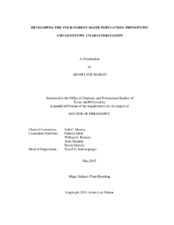| dc.description.abstract | In order to gain a better understanding of the effects and amount of recombination that can be available to future plant breeding endeavors, a unique mapping population was created. A di-hybrid maize (Zea mays L.) cross was used in this study to create inter-crossed recombinant inbred lines (IRILs). The four parents include two with blue aleurone, one with high oleic acid, and a highly aflatoxin resistant publicly available inbred, Tx772. The 1291 line population consisted of six sub-populations with various levels of crossing and inter-crossing which afforded the opportunity to examine an array of mapping population designs for phenotypic diversity, as well as genetic mapping effectiveness. An especially important outcome of this study for future maize genetic studies was to determine whether it is more prudent to increase the size of mapping populations, to increase the number of parents, or to add additional cycles of intermating. The added increased effective recombination in several of the sub-populations produced greater diversity of phenotypes and an increase in quantitative trait locus/ loci (QTL) accuracy and resolution in some cases. Phenotypic variation and genetic mapping resolution were to a greater extent affected by population size.
Significant variation was observed for days to anthesis and silk, plant and ear height, leaf rolling, as well as cob and kernel color. Questions and outcomes that this population addressed concerning practical plant breeding applications included the added difficulty that various mapping population designs create, and that a direct relationship between increased phenotypic and genotypic variation and additional parents or intermating cycles did not seem to exist. Instead, variation was specific for the population and target trait in question. From a molecular and genetic mapping standpoint, the 4way population without intermating detected the gene for cob color, while the only other two groups that detected it were the 4way3sib, as well as all 4way subpopulations combined; both which had the largest population sizes, excluding the entire population which contained bi-parental populations. Because only one of the four parents, B73Olc1, expressed red cob, this observation may prove useful for future studies where a target trait is under represented in available germplasm. This indicates that larger population sizes, more so than exotic population designs may lead to improved results. Due to the incorporation of diverse mating designs, this population is a unique resource for future research including additional phenotypic analysis, genetic map construction, QTL linkage mapping, and analysis of recombination rate. | en |


